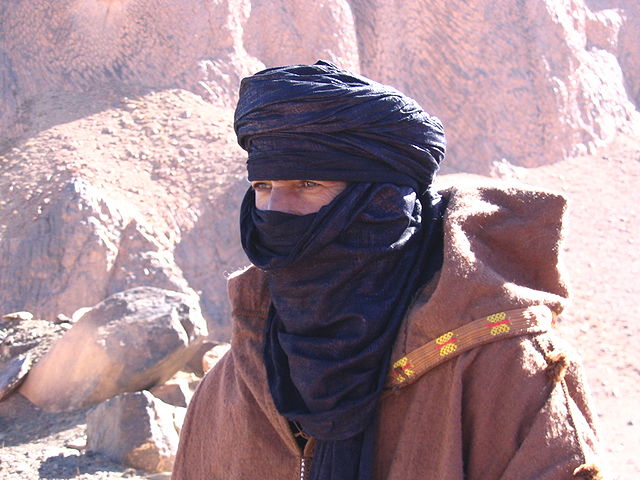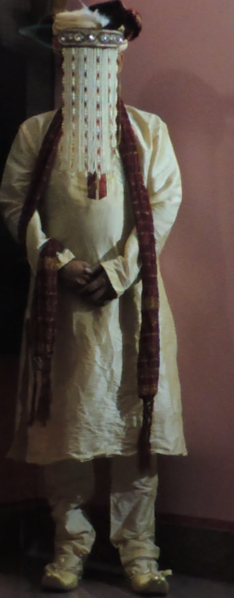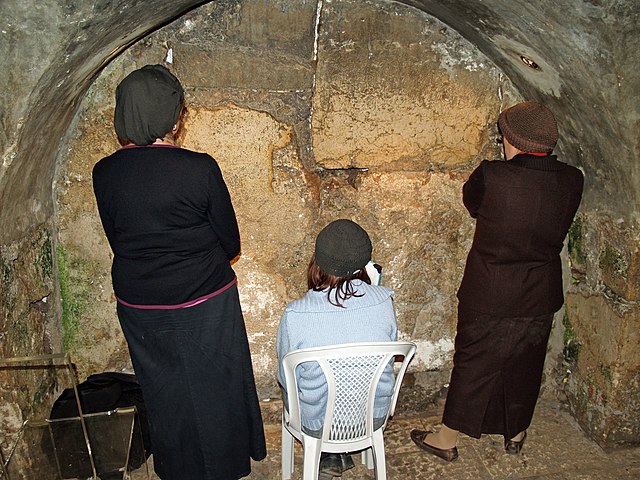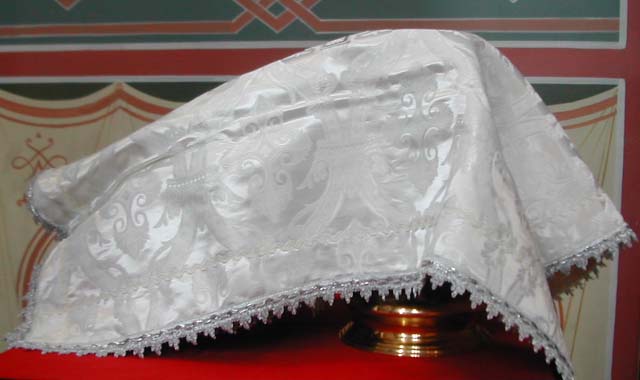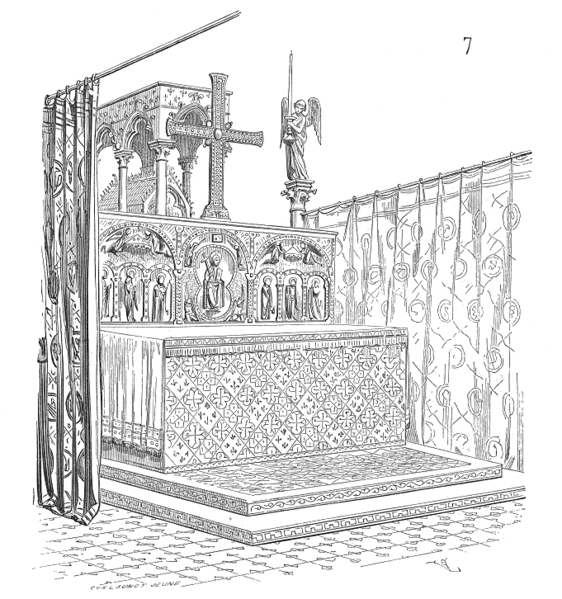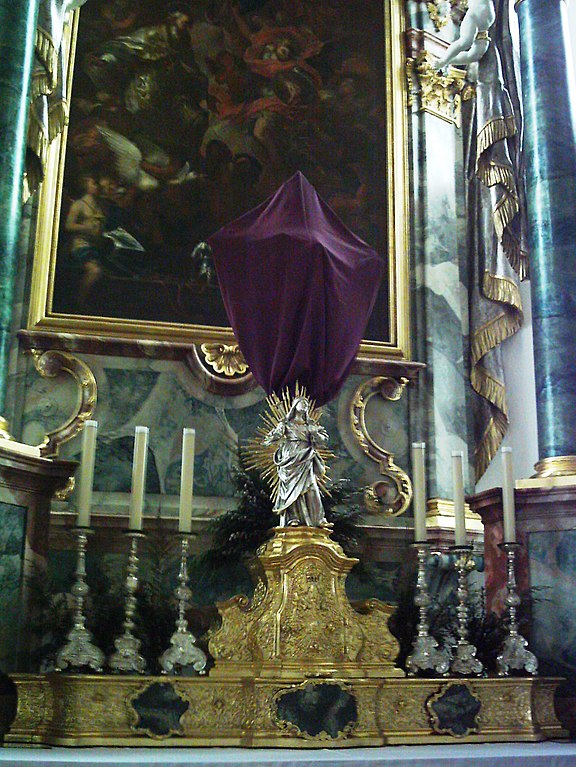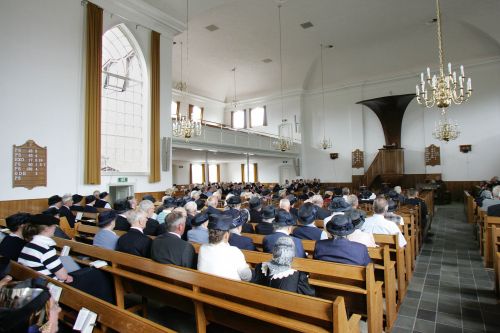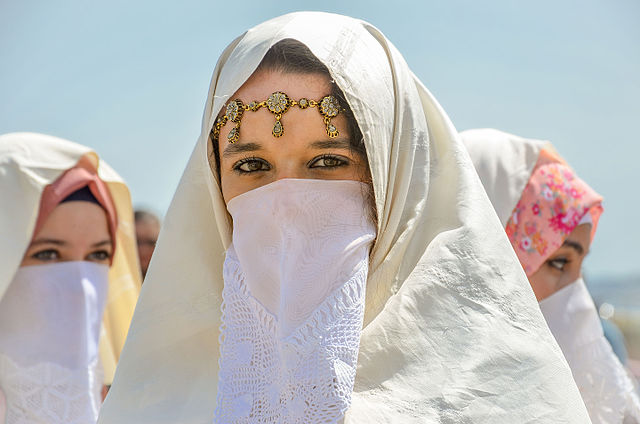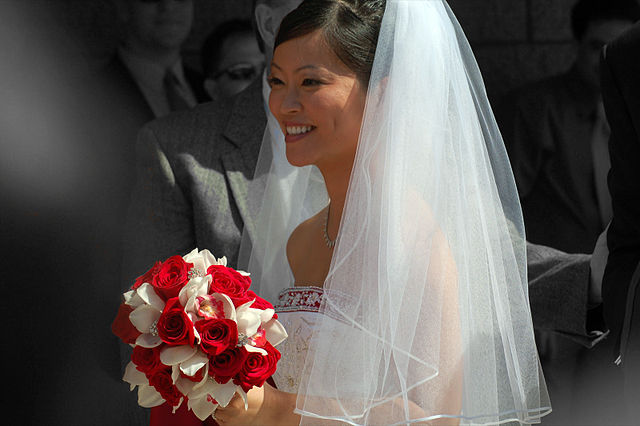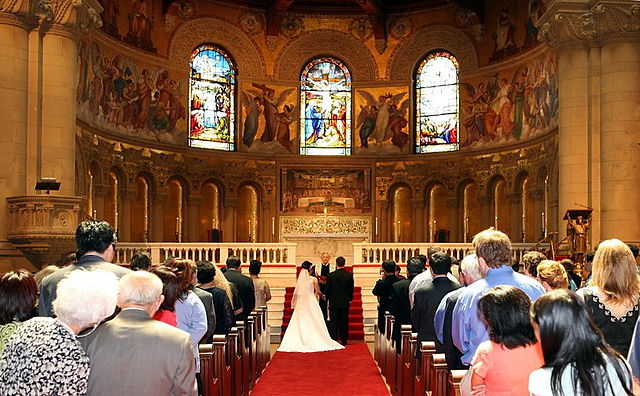
| VEIL IN DIFFERENT RELIGIONS A veil is an article of clothing or hanging cloth that is intended to cover some part of the head or face, or an object of some significance. Veiling has a long history in European, Asian, and African societies. The practice has been prominent in different forms in Judaism, Christianity, and Islam. The practice of veiling is especially associated with women and sacred objects, though in some cultures it is men rather than women who are expected to wear a veil. Besides its enduring religious significance, veiling continues to play a role in some modern secular contexts, such as wedding customs.
Roman statue of a veiled Vestal Virgin History :
Greek bronze statuette of a veiled and masked dancer, 2nd–3rd century BC
Antiquity :
The Middle Assyrian law code states :
§ 40. A wife-of-a-man, or [widows], or [Assyrian] women who go out into the main thoroughfare [shall not have] their heads [bare]. A prostitute shall not veil herself, her head shall be bare. Whoever sees a veiled prostitute shall seize her, secure witnesses, and bring her to the palace entrance. They shall not take her jewelry; he who has seized her shall take her clothing; they shall strike her 50 blows with rods; they shall pour hot pitch over her head. And if a man should see a veiled prostitute and release her and not bring her to the palace entrance: they shall strike that man 50 blows with rods; the one who informs against him shall take his clothing; they shall pierce his ears, thread (them) on a cord, tie (it) at his back; he shall perform the king’s service for one full month. Slave-women shall not veil themselves, and he who should see a veiled slave-woman shall seize her and bring her to the palace entrance: they shall cut off her ears; he who seizes her shall take her clothing.
Veiling was thus not only a marker of aristocratic rank, but also served to "differentiate between 'respectable' women and those who were publicly available". The veiling of matrons was also customary in ancient Greece. Between 550 and 323 B.C.E respectable women in classical Greek society were expected to seclude themselves and wear clothing that concealed them from the eyes of strange men.
The Mycenaean Greek term, a-pu-ko-wo-ko, possibly meaning "headband makers" or "craftsmen of horse veil", and written in Linear B syllabic script, is also attested since ca. 1300 BC.
Classical Greek and Hellenistic statues sometimes depict Greek women with both their head and face covered by a veil. Caroline Galt and Lloyd Llewellyn-Jones have both argued from such representations and literary references that it was commonplace for women (at least those of higher status) in ancient Greece to cover their hair and face in public. Roman women were expected to wear veils as a symbol of the husband's authority over his wife; a married woman who omitted the veil was seen as withdrawing herself from marriage. In 166 BC, consul Sulpicius Gallus divorced his wife because she had left the house unveiled, thus allowing all to see, as he said, what only he should see. Unmarried girls normally didn't veil their heads, but matrons did so to show their modesty and chastity, their pudicitia. Veils also protected women against the evil eye, it was thought.
A veil called flammeum was the most prominent feature of the costume worn by the bride at Roman weddings. The veil was a deep yellow color reminiscent of a candle flame. The flammeum also evoked the veil of the Flaminica Dialis, the Roman priestess who could not divorce her husband, the high priest of Jupiter, and thus was seen as a good omen for lifelong fidelity to one man. The Romans apparently thought of the bride as being "clouded over with a veil" and connected the verb nubere (to be married) with nubes, the word for cloud.
Intermixing of populations resulted in a convergence of the cultural practices of Greek, Persian, and Mesopotamian empires and the Semitic peoples of the Middle East. Veiling and seclusion of women appear to have established themselves among Jews and Christians, before spreading to urban Arabs of the upper classes and eventually among the urban masses. In the rural areas it was common to cover the hair, but not the face.
Later history :
Depiction of Isabeau of Bavaria, queen of France, wearing veiling For many centuries, until around 1175, Anglo-Saxon and then Anglo-Norman women, with the exception of young unmarried girls, wore veils that entirely covered their hair, and often their necks up to their chins (see wimple). Only in the Tudor period (1485), when hoods became increasingly popular, did veils of this type become less common. This varied greatly from one country to another. In Italy, veils, including face veils, were worn in some regions until the 1970s. Women in southern Italy often covered their heads to show that they were modest, well-behaved and pious. They generally wore a cuffia (cap), then the fazzoletto (kerchief/head scarves) a long triangular or rectangular piece of cloth that could be tied in various way, and sometimes covered the whole face except the eyes, sometimes bende (lit. swaddles, bandages) or a wimple underneath too.
For centuries, European women have worn sheer veils, but only under certain circumstances. Sometimes a veil of this type was draped over and pinned to the bonnet or hat of a woman in mourning, especially at the funeral and during the subsequent period of "high mourning". They would also have been used, as an alternative to a mask, as a simple method of hiding the identity of a woman who was traveling to meet a lover, or doing anything she didn't want other people to find out about. More pragmatically, veils were also sometimes worn to protect the complexion from sun and wind damage (when un-tanned skin was fashionable), or to keep dust out of a woman's face, much as the keffiyeh(worn by men) is used today.
Coptic Christian woman wearing a veil (1918) In Judaism, Christianity, and Islam the concept of covering the head is or was associated with propriety and modesty. Most traditional depictions of the Virgin Mary, the mother of Christ, show her veiled. During the Middle Ages most European married women covered their hair rather than their face, with a variety of styles of wimple, kerchiefs and headscarves. Veiling, covering the hair, rather than the face, was a common practice with church-going women until the 1960s, Catholic women typically using lace, and a number of very traditional churches retain the custom. Bonnets were the rule in non-Catholic churches. Lace face-veils are still often worn by female relatives at funerals in some Catholic countries. In Orthodox Judaism, married women cover their hair for reasons of modesty; many Orthodox Jewish women wear headscarves (tichel) for this purpose.
Christian Byzantine literature expressed rigid norms pertaining to veiling of women, which have been influenced by Persian traditions, although there is evidence to suggest that they differed significantly from actual practice. Since Islam identified with the monotheistic religions practiced in the Byzantine and Sassanian empires, in the aftermath of the early Muslim conquests veiling of women was adopted as an appropriate expression of Qur'anic ideals regarding modesty and piety. Veiling gradually spread to upper-class Arab women, and eventually, it became widespread among Muslim women in cities throughout the Middle East. Veiling of Arab Muslim women became especially pervasive under Ottoman rule as a mark of rank and exclusive lifestyle, and Istanbul of the 17th century witnessed differentiated dress styles that reflected geographical and occupational identities. Women in rural areas were much slower to adopt veiling because the garments interfered with their work in the fields. Since wearing a veil was impractical for working women, "a veiled woman silently announced that her husband was rich enough to keep her idle." By the 19th century, upper-class urban Muslim and Christian women in Egypt wore a garment which included a head cover and a burqa (muslin cloth that covered the lower nose and the mouth). Up to the first half of the twentieth century, rural women in the Maghreb and Egypt put on a face veil when they visited urban areas, "as a sign of civilization".
The practice of veiling gradually declined in much of the Muslim world during the 20th century before making a comeback in recent decades The choice, or the forced option for women to veil remains controversial, whether a personal choice as an outward sign of religious devotion, or a forced one because of extremist groups that require a veil, under severe penalty, even death. The motives and reasons for wearing a hijab are wide and various, but ultimately depend on each individual person's situation and can not be said to come from any one distinct reason or motive. Although religion can be a common reason for choosing to veil, the practice also reflects political and personal conviction, so that it can serve as a medium through which personal choices can be revealed, in countries where veiling is indeed a choice, such as Turkey.
Veils for men :
Tuareg man wearing a veil Among the Tuareg, Songhai, Hausa, and Fulani of West Africa, women do not traditionally wear the veil, while men do. Male veiling was also common among the Berber Sanhaja tribes. The North African male veil, which covers the mouth and sometimes part of the nose, is called litham in Arabic and tagelmust by the Tuareg. Tuareg boys start wearing the veil at the onset of puberty and veiling is regarded as a mark of manhood. It is considered improper for a man to appear unveiled in front of elders, especially those from his wife's family.
Ancient African rock engravings depicting human faces with eyes but no mouth or nose suggest that the origins of litham are not only pre-Islamic but even pre-historic. Wearing of the litham is not viewed as a religious requirement, although it was apparently believed to provide magical protection against evil forces. In practice, the litham has served as protection from the dust and extremes of temperature characterizing the desert environment. Its use by the Almoravids gave it a political significance during their conquests.
Indian groom in traditional attire, with Sherwani, Sehra and Mojdi In some parts of India, Pakistan, Bangladesh, and Nepal, men wear a sehra on their wedding day. This is a male veil covering the whole face and neck. The sehra is made from either flowers or beads. The most common Sehra (headdress) is made from fresh marigolds. The groom wears this throughout the day concealing his face even during the wedding ceremony. In Northern India today you can see the groom arriving on a horse with the sehra wrapped around his head.
Veiling and religion :
Biblical
references
Note :
Genesis 20:16, which the King James Version renders as: "And unto Sarah he said, Behold, I have given thy brother a thousand pieces of silver: behold, he is to thee a covering of the eyes, unto all that are with thee, and with all other: thus she was reproved" has been interpreted in one source as implied advice to Sarah to conform to a supposed custom of married women, and wear a complete veil, covering the eyes as well as the rest of the face, but the phrase is generally taken to refer not to Sarah's eyes, but to the eyes of others, and to be merely a metaphorical expression concerning vindication of Sarah (NASB, RSV), silencing criticism (GWT), allaying suspicions (NJB), righting a wrong (BBE, NLT), covering or recompensing the problem caused her (NIV, New Life Version, NIRV, TNIV, JB), a sign of her innocence (ESV, CEV, HCSB). The final phrase in the verse, which KJV takes to mean "she was reproved", is taken by almost all other versions to mean instead "she was vindicated", and the word, which KJV interprets as "he" (Abraham), is interpreted as "it" (the money). Thus, the general view is that this passage has nothing to do with material veils.
Praying Jewish woman wearing Tichel Judaism :
Christianity :
Aër covering a chalice and diskos on the prothesis
Sanctuary in the Basilique Saint-Denis showing veiling to either side of the altar
An altar cross veiled during Holy Week
Western burse and chalice veil laid over the holy vessels. There is also a maniple sitting to the right of the chalice
Veiling of objects :
1.
Tabernacle veil :
Veiling by women :
Headcovering in the Restored Reformed Church of Doornspijk
Women of the Russian Orthodox Old-Rite Church wearing Christian headcoverings Traditionally, in Christianity, women were enjoined to cover their heads when praying both in church and at home, just as it was (and still is) customary for men to remove their hat as a sign of respect. Wearing a veil (also known as a headcovering) is seen as a sign of humility before God, as well as a reminder of the bridal relationship between Christ and the church. This practice is based on 1 Corinthians 11:4–16 in the Christian Bible, where St. Paul writes :
Now I praise you, brethren, that ye remember me in all things, and keep the ordinances, as I delivered them to you. But I would have you know, that the head of every man is Christ; and the head of the woman is the man; and the head of Christ is God. Every man praying or prophesying, having his head covered, dishonoureth his head. But every woman that prayeth or prophesieth with her head uncovered dishonoureth her head: for that is even all one as if she were shaven. For if the woman be not covered, let her also be shorn: but if it be a shame for a woman to be shorn or shaven, let her be covered. For a man indeed ought not to cover his head, forasmuch as he is the image and glory of God: but the woman is the glory of the man. For the man is not of the woman: but the woman of the man. Neither was the man created for the woman; but the woman for the man. For this cause ought the woman to have power on her head because of the angels. Nevertheless neither is the man without the woman, neither the woman without the man, in the Lord. For as the woman is of the man, even so is the man also by the woman; but all things of God. Judge in yourselves: is it comely that a woman pray unto God uncovered? Doth not even nature itself teach you, that, if a man have long hair, it is a shame unto him? But if a woman have long hair, it is a glory to her: for her hair is given her for a covering. But if any man seem to be contentious, we have no such custom, neither the churches of God.
In Western Europe and North America, from the arrival of Christianity to those lands to the start of the 20th century, women in most mainstream Christian denominations wore head coverings during church services (often in the form of a scarf, cap, veil or hat). These included many Anglican, Baptist, Catholic, Lutheran, Methodist, Presbyterian Churches. In these denominations, the practice now continues in isolated parishes where it is seen as a matter of etiquette, courtesy, tradition or fashionable elegance.
Christian veiling is still practiced, especially among those who wear plain dress, such as Conservative Quakers and many Anabaptists (including Mennonites, Hutterites, Old German Baptist Brethren, Apostolic Christians and Amish). Moravian females wear a lace headcovering called a haube, especially when serving as dieners. Many Holiness Christians who practice the doctrine of outward holiness, also practice headcovering, in addition to the Laestadian Lutheran Church, the Plymouth Brethren, and the more conservative Scottish and Irish Presbyterian and Dutch Reformed churches. Traditionalist Catholics still follow it, generally as a matter of custom and biblically approved aptness; some also suppose that St. Paul's directive is in full force today as an ordinance of its own right, despite the teaching of the Congregation for the Doctrine of the Faith's pronouncement on the matter, which stated that practice of headcovering for women was a matter of ecclesiastical discipline and not of Divine law;
In many traditional Eastern Orthodox Churches, and in some conservative Protestant churches as well, the custom of women's covering their heads continues in church (and when praying privately at home).
Veiling
by nuns :
Nuns are the female counterparts of monks, and many monastic orders of women have retained the veil. Regarding other institutes of religious sisters who are not cloistered but who work as teachers, nurses or in other "active" apostolates outside of a nunnery or monastery, some wear the veil, while some others have abolished the use of the veil, and a few never had a veil to start with, but used a bonnet-style headdress as in the case of St. Elizabeth Ann Seton.
The fullest versions of the nun's veil cover the top of the head and flow down around and over the shoulders. In western Christianity, it does not wrap around the neck or face. In those orders that retain one, the starched white covering about the face, neck, and shoulders is known as a wimple and is a separate garment.
The Catholic Church has revived the ancient practice of allowing women to be consecrated by their bishop as a consecrated virgin. These women are set aside as sacred persons who belong only to Christ and the service of the church. The veil is a bridal one, because the velatio virginum primarily signified the newly consecrated virgin as the Bride of Christ. At one point this veil was called the flammeum because it was supposed to remind the virgin of the indissoluble nuptial bond she was contracting with Christ. The wearing of the flammeum for the sacred virgin Bride of Christ arose from the bridal attire of the strictest pagan marriage which did not permit of divorce at the time. The flammeum was a visible reminder that divorce was not possible with Christ, their Divine Spouse. Consecrated virgins are under the direct care of the local bishop, without belonging to a particular order, and they receive the veil as a bridal sign of consecration.
There has also been renewed interest in the last half century in the ancient practice of women and men dedicating themselves as anchorites or hermits, and there is a formal process whereby such persons can seek recognition of their vows by the local bishop; a veil for these women would be traditional.
Some Lutheran and Anglican women's religious orders also wear a veil, differing according to the traditions of each order.
In Eastern Orthodoxy and in the Eastern Rites of the Catholic Church, a veil called an epanokamelavkion is used by both nuns and monks, in both cases covering completely the kamilavkion, a cylindrical hat they both wear. In Slavic practice, when the veil is worn over the hat, the entire headdress is referred to as a klobuk. Nuns wear an additional veil under the klobuk, called an apostolnik, which is drawn together to cover the neck and shoulders as well as the head, leaving the face itself open.
Islam :
Women in the predominantly Islamic country of Algeria wearing a haïk, a type of veil A variety of headdresses worn by Muslim women and girls in accordance with hijab (the principle of dressing modestly) are sometimes referred to as veils. The principal aim of the Muslim veil is to cover the Awrah (parts of the body that are considered private). Many of these garments cover the hair, ears and throat, but do not cover the face.
Depending on geography and culture, the veil is referenced and worn in different ways. The khimar is a type of headscarf. The niqab and burqa are two kinds of veils that cover most of the face except for a slit or hole for the eyes. In Algeria, a larger veil called the haïk includes a triangular panel to cover the lower part of the face. In the Arabian Peninsula and parts of North Africa (specifically Saudi Arabia), the abaya is worn constructed like a loose robe covering everything but the face itself. In another location, such as Iran, the chador is worn as the semicircles of fabric are draped over the head like a shawl and held in place under the neck by hand. The two terms for veiling that are directly mentioned in the Quran is the jilbab and the khimar. In these references, the veiling is meant to promote modesty by covering the genitals and breasts of women.
The Afghan burqa covers the entire body, obscuring the face completely, except for a grille or netting over the eyes to allow the wearer to see. The boshiya is a veil that may be worn over a headscarf; it covers the entire face and is made of a sheer fabric so the wearer is able to see through it. It has been suggested that the practice of wearing a veil – uncommon among the Arab tribes prior to the rise of Islam – originated in the Byzantine Empire, and then spread.
The Bedouin living in Southern Palestine and the Sinai peninsula also use face veils. The traditional veils in Palestine are short and decorated with coins. In northern Sinai, the veil sections are longer and often contain embroidery, chains, pendants, beads, The Bedouin-style mask is known as al-maghrun, al-baghrah or al-niqab.
In the UAE, Qatar and Oman, a face mask known as the burghu is used, and Bahrain, Qatar and Oman, the batulah is used.
In Central Asian sedentary Muslim areas (today Uzbekistan and Tajikistan) women wore veils which when worn the entire face was shrouded, called Paranja or faranji. The traditional veil in Central Asia worn before modern times was the faranji but it was banned by the Soviet Communists.
Restrictions
:
•
France, where full-face veils (burqa and niqab) have been banned
in public places since April 2011, with a 150-euro fine for breaching
the ban. All religious veils have been banned in public schools.
•
United Kingdom, where the Home Office Minister Jeremy Browne called
for a national debate about headscarves and their role in public
environments in Britain.
Stay, stay, O daughter-in-law - do not cover your face with a veil. In the end, this shall not bring you even half a shell. The one before you used to veil her face; do not follow in her footsteps. The only merit in veiling your face is that for a few days, people will say, "What a noble bride has come". Your veil shall be true only if you skip, dance and sing the Glorious Praises of the Lord. Says Kabeer, the soul-bride shall win, only if she passes her life singing the Lord's Praises.
- Bhagat Kabir, Guru Granth Sahib 484
Bridal veils :
A bride wearing a typical wedding veil The veil is one of the oldest parts of a bridal ensemble, dating as far back as Greek and Roman times, to hide a bride "from evil spirits who might want to thwart her happiness" or to frighten the spirits away. The veil also served to hide the bride's face from the groom prior to the wedding, as superstition says that it is bad luck for the groom to see the bride before the ceremony. As weddings became more religious ceremonies in Western culture, the veil was used to symbolize modesty before God, obedience, and when the veil was white, chastity. By the 17th and 18th century, bridal veils were occasionally worn, but were generally out of fashion in Britain and North America, with brides choosing from many other options instead. However, the bridal veil returned to popularity after Queen Victoria wore a veil in her wedding to Prince Albert in 1840. The bridal veil became a status symbol during the Victorian era, and the weight, length, and quality of the veil indicated the bride's social status. Bridal veils worn over the face were not common until the second half of the 19th century.
The tradition of a veiled bride's face continues today wherein, a virgin bride, especially in Christian or Jewish culture, enters the marriage ritual with a veiled face and head, and remains fully veiled, both head and face, until the ceremony concludes. After the full conclusion of the wedding ceremony, either the bride's father lifts the veil, presenting the bride to the groom who then kisses her, or the new groom lifts her face veil in order to kiss her. Some see the lifting of the veil as symbolically consummating the marriage, representing another thin membrane (the hymen) that will be physically penetrated on the wedding night.
In modern weddings, the lifting of the veil at the conclusion of the ceremony to present the bride to the groom may not occur, since it may be considered sexist for the bride to have her face covered through the ceremony, whether or not the veil is worn to symbolize virginity. Often the veil is worn solely as a fashion accessory as part of the bridal attire, instead of for its symbolism. A bridal veil is not normally worn during a civil marriage ceremony, nor when the bride is remarrying.
In Scandinavia, the bridal veil is usually worn under a traditional crown and does not cover the bride’s face; instead, the veil is attached to and hangs from the back.
Judaism :
An Orthodox Jewish wedding in Vienna, where the bride is wearing a traditional veil In Judaism, the tradition of the bride wearing a veil during the wedding ceremony dates back to biblical times. According to the Torah in Genesis 24:65, Isaac is brought Rebekah to marry by his father Abraham's servant, and Rebekah took her veil and covered herself when Isaac was approaching.
In a traditional Jewish wedding, just before the ceremony, the badeken takes place, at which the groom places the veil over the bride's face, and either he or the officiating rabbi gives her a blessing. The veil stays on her face until just before the end of the wedding ceremony – when they are legally married according to Jewish law – then the groom helps lift the veil off her face. The most often cited interpretation for the badeken is that, according to Genesis 29, when Jacob went to marry Rachel, his father-in-law Laban tricked him into marrying Leah, Rachel's older and homelier sister.
Many say that the veiling ceremony takes place to make sure that the groom is marrying the right bride. Some say that as the groom places the veil over his bride, he makes an implicit promise to clothe and protect her. Finally, by covering her face, the groom recognizes that he is marrying the bride for her inner beauty; while looks will fade with time, his love will be everlasting. In some ultra-orthodox communities, it is a custom for the bride to wear an opaque veil as she is escorted to the groom. This is said to show her complete willingness to enter into the marriage and her absolute trust that she is marrying the right man.
In ancient Judaism, the lifting of the veil took place just prior to the consummation of the marriage in sexual union. The uncovering or unveiling that takes place in the wedding ceremony is a symbol of what will take place in the marriage bed. Just as the two become one through their words spoken in wedding vows, so these words are a sign of the physical oneness that they will consummate later on. The lifting of the veil is a symbol and anticipation of this.
Christianity :
A Christian minister marries a groom and bride, the latter of whom is wearing a wedding veil in the church In Christian theology, St. Paul's words concerning how marriage symbolizes the union of Christ and His Church underlie part of the tradition of veiling in the marriage ceremony. In Catholic traditions, the veil is seen as "a visible sign that the woman is under the authority of a man" and that she is submitting herself to her husband's Christ-like leadership and loving care.
The removing of the veil can be seen as a symbol of the temple veil that was torn when Christ died, giving believers direct access to God, and in the same way, the bride and the groom, once married, now have full access to one another.
Church
of Jesus Christ of Latter-day Saints :
Mourning
veils :
Mourning veils have also been sometimes perceived as expressions of elegance or even sex appeal. In a 19th-century American etiquette book one finds: "Black is becoming, and young widows, fair, plump, and smiling, with their roguish eyes sparkling under their black veils are very seducing".
Interpretations
:
A veil also has symbolic interpretations, as something partially concealing, disguising, or obscuring.
Etymology
:
Source :
https://en.wikipedia.org/ |
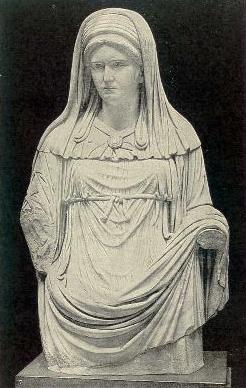
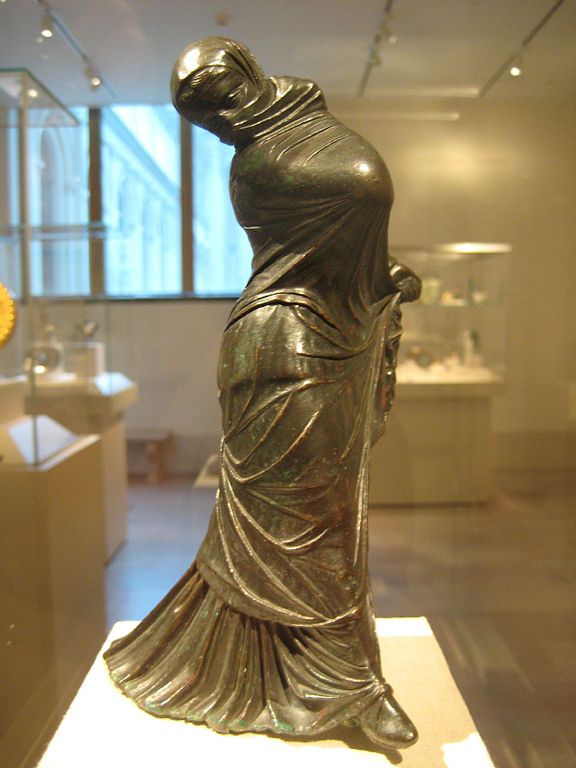
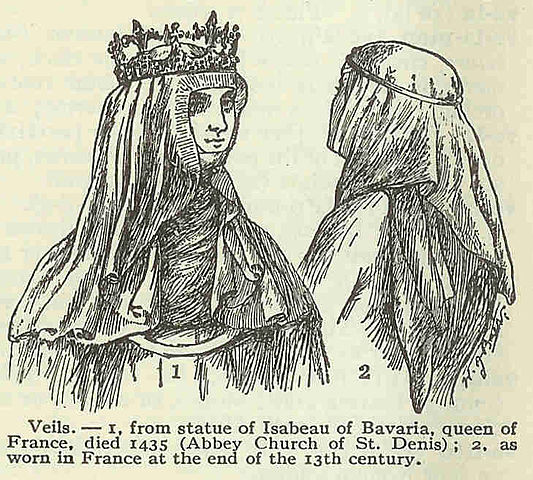
_-_TIMEA.jpg)
